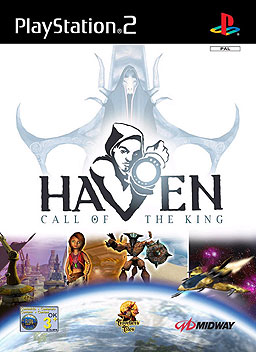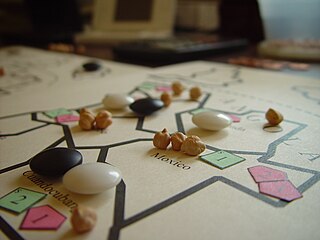
A wargame is a strategy game in which two or more players command opposing armed forces in a simulation of some military operation. Wargaming may be played for recreation, to train military officers in the art of strategic thinking, or to study the nature of potential conflicts. Many wargames re-create specific historic battles, and can cover either whole wars, or any campaigns, battles, or lower-level engagements within them. Many simulate land combat, but there are wargames for naval and air combat, as well.

Determinism is the philosophical view that all events in the universe, including human decisions and actions, are causally inevitable. Deterministic theories throughout the history of philosophy have developed from diverse and sometimes overlapping motives and considerations. Like eternalism, determinism focuses on particular events rather than the future as a concept. The opposite of determinism is indeterminism, or the view that events are not deterministically caused but rather occur due to chance. Determinism is often contrasted with free will, although some philosophers claim that the two are compatible.
In business and engineering, product development or new product development covers the complete process of bringing a new product to market, renewing an existing product and introducing a product in a new market. A central aspect of NPD is product design, along with various business considerations. New product development is described broadly as the transformation of a market opportunity into a product available for sale. The products developed by an organisation provide the means for it to generate income. For many technology-intensive firms their approach is based on exploiting technological innovation in a rapidly changing market.

In human–computer interaction, paper prototyping is a widely used method in the user-centered design process, a process that helps developers to create software that meets the user's expectations and needs – in this case, especially for designing and testing user interfaces. It is throwaway prototyping and involves creating rough, even hand-sketched, drawings of an interface to use as prototypes, or models, of a design. While paper prototyping seems simple, this method of usability testing can provide useful feedback to aid the design of easier-to-use products. This is supported by many usability professionals.
Gameplay is the specific way in which players interact with a game, and in particular with video games. Gameplay is the pattern defined through the game rules, connection between player and the game, challenges and overcoming them, plot and player's connection with it. Video game gameplay is distinct from graphics and audio elements. In card games, the equivalent term is play.
Video game design is the process of designing the rules and content of video games in the pre-production stage and designing the gameplay, environment, storyline and characters in the production stage. Some common video game design subdisciplines are world design, level design, system design, content design, and user interface design. Within the video game industry, video game design is usually just referred to as "game design", which is a more general term elsewhere.

Rise of Nations is a real-time strategy video game developed by Big Huge Games and published by Microsoft Game Studios in May 2003. Designed as a fusion of concepts from turn-based strategy games with the real-time strategy genre, the game's development was led by Brian Reynolds, who founded Big Huge Games following his involvement in the development of the turn-based strategy games Civilization II and Sid Meier's Alpha Centauri. In contrast to previous historical real-time strategy games, Rise of Nations is based on the entirety of history, taking place from the ancient era to the modern age, and features eighteen civilizations, playable across eight ages of world history. The game features several innovations on the real-time strategy genre, introducing novel features such as territory and attrition influenced by the turn-based strategy genre.

In systems engineering, information systems and software engineering, the systems development life cycle (SDLC), also referred to as the application development life cycle, is a process for planning, creating, testing, and deploying an information system. The SDLC concept applies to a range of hardware and software configurations, as a system can be composed of hardware only, software only, or a combination of both. There are usually six stages in this cycle: requirement analysis, design, development and testing, implementation, documentation, and evaluation.
Video game development is the process of creating a video game. It is a multidisciplinary practice, involving programming, design, art, audio, user interface, and writing. Each of those may be made up of more specialized skills; art includes 3D modeling of objects, character modeling, animation, visual effects, and so on. Development is supported by project management, production, and quality assurance. Teams can be many hundreds of people, a small group, or even a single person.
Product design is the process of creating new products for sale businesses to its customers. It involves the generation and development of ideas through a systematic process that leads to the creation of innovative products. Thus, it is a major aspect of new product development.
In tabletop games and video games, game mechanics are the rules or ludemes that govern and guide the player's actions, as well as the game's response to them. A rule is an instruction on how to play, a ludeme is an element of play like the L-shaped move of the knight in chess. A game's mechanics thus effectively specify how the game will work for the people who play it.
Game balance is a branch of game design with the intention of improving gameplay and user experience by balancing difficulty and fairness. Game balance consists of adjusting rewards, challenges, and/or elements of a game to create the intended player experience.
Technical communication is communication of technical subject matter such as engineering, science, or technology content. The largest part of it tends to be technical writing, though importantly it often requires aspects of visual communication. Technical communication also encompasses oral delivery modes such as presentations involving technical material. When technical communication occurs in workplace settings, it's considered a major branch of professional communication. In research or R&D contexts, it can overlap with scientific writing.
A lesson plan is a teacher's detailed description of the course of instruction or "learning trajectory" for a lesson. A daily lesson plan is developed by a teacher to guide class learning. Details will vary depending on the preference of the teacher, subject being covered, and the needs of the students. There may be requirements mandated by the school system regarding the plan. A lesson plan is the teacher's guide for running a particular lesson, and it includes the goal, how the goal will be reached and a way of measuring how well the goal was reached.

Haven: Call of the King is a 2002 multi-genre action-adventure video game developed by Traveller's Tales and published by Midway Games for the PlayStation 2. The game was also scheduled for release on the Xbox and GameCube, to be published by Xicat Interactive, but both versions were cancelled. A Game Boy Advance version was also planned, but never got beyond the earliest developmental stages.
The engineering design process, also known as the engineering method, is a common series of steps that engineers use in creating functional products and processes. The process is highly iterative – parts of the process often need to be repeated many times before another can be entered – though the part(s) that get iterated and the number of such cycles in any given project may vary.
Modern elementary mathematics is the theory and practice of teaching elementary mathematics according to contemporary research and thinking about learning. This can include pedagogical ideas, mathematics education research frameworks, and curricular material.

Game design is the process of creating and shaping the mechanics, systems and rules of a game. Games can be created for entertainment, education, exercise or experimental purposes. Additionally, elements and principles of game design can be applied to other interactions, in the form of gamification. Game designer and developer Robert Zubek defines game design by breaking it down into its elements, which he says are the following:

Lara Croft Go is a turn-based puzzle video game in the Tomb Raider series. The player moves Lara Croft as a puzzle piece through a board game while avoiding obstacles and manipulating the environment. The developers distilled major series motifs, such as boulder-chases and reaction-based gameplay, to suit Lara Croft Go's time-independent gameplay. Square Enix Montréal developed the game as a spiritual successor to its 2014 Hitman Go, based on another Square Enix Europe franchise. It was released in August 2015 for Android, iOS, Windows, and Windows Phone devices. Versions for PlayStation 4, PlayStation Vita and Steam were released in December 2016.
The protection of intellectual property (IP) of video games through copyright, patents, and trademarks, shares similar issues with the copyrightability of software as a relatively new area of IP law. The video game industry itself is built on the nature of reusing game concepts from prior games to create new gameplay styles but bounded by illegally direct cloning of existing games, and has made defining intellectual property protections difficult since it is not a fixed medium.








